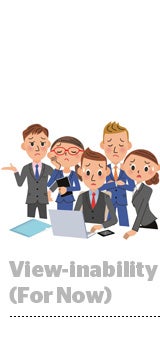 “I don’t care if only a portion of my ads are actually seen,” said no advertiser ever. But 100% viewability is still a work in progress.
“I don’t care if only a portion of my ads are actually seen,” said no advertiser ever. But 100% viewability is still a work in progress.
The Interactive Advertising Bureau (IAB) issued a report Tuesday in which it emphatically stated that 100% viewability simply “isn’t possible,” setting 70% as a more realistic threshold, at least for now.
It seems that the IAB is looking to mitigate some of the industry pushback it’s been getting from advertisers and agencies who are less than pleased with the way viewability has been shaking out. In the words of IAB President and CEO Randall Rothenberg, “it’s time to set the record straight about what is technically and commercially feasible.”
The paper calls for a reality check. The Media Ratings Council lifted its advisory against trading on viewable impressions back in March – 50% in-view for one second for display, two continuous seconds for video.
However, advertisers have been clamoring for more. One such advertiser – one of the biggest in the world – is CPG giant of giants Unilever, which, along with its agency Mindshare/GroupM, has said that ad campaigns shouldn’t be counted unless they deliver 100% viewability.
“There was a tremendous amount of excitement and positive anticipation about the standard and the MRC accreditation about a year ago, but perhaps the expectations were overly optimistic,” said Forrester senior analyst Susan Bidel. “But I’m not going to say that the IAB was premature. They did it in the best manner they could at the time.”
The IAB is calling 2015 a “year of transition,” a time when the advertising community – advertisers, publishers, agencies and tech vendors alike – should work together to make viewability into a currency that serves the needs of all stakeholders.
Until then, 70% is a practical interim solution, and that’s only fair, said Sherrill Mane, the IAB’s SVP of research, analytics and measurement. The variability that exists in the space right now – different ad units, browsers, placements, vendors and measurement methodologies – mean that there’s still work to be done. The IAB report contains a series of recommendations to encourage greater collaboration in the coming year, including tips on billing and make-goods.
“The road to 100% viewability is complex,” Mane said. “The entire ecosystem must work collaboratively on improving education and measurement. It’s vital that we adhere to the standards that MRC has overseen and will continue to oversee – otherwise, we will have measurement and supply chain dysfunction that will make the realization of the power of digital media alone and as part of a cross-media platform plan, nearly impossible to realize.”
Although players like Unilever and Condé Nast aren’t happy with the current state of affairs, Mane was quick to point out that not everyone is as draconian in their viewability demands. “It’s not the industry that expects 100% viewability, it’s a few companies,” she said.
Vik Kathuria, global chief media officer at Razorfish and a Mediacom vet, also cut the standard some slack.
AdExchanger Daily
Get our editors’ roundup delivered to your inbox every weekday.
Daily Roundup
“The digital ecosystem is evolving at a rapid pace and it is critical for us as stewards of our clients’ media strategy to focus not on media output but relevant business results,” he said “Viewability is one of the many factors, along with click fraud, where the focus needs to be on accountability by the publishers.”
But Bidel, for her part, is quick to point out the need to be clear on the difference between viewability and fraud.
“I wrote a report myself on fraud and I tried hard to make a distinction between them,” said Bidel, who does most of her research on the sell side. “Viewability is an issue that everyone understands and everyone is actively trying to deal with – and my feeling is: Good luck to them all.”













